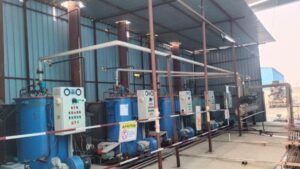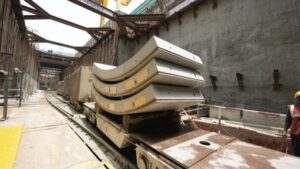
The northern part of India is experiencing an unprecedented cold wave, which has slowed down construction works in the region. However, the construction of the Delhi-Ghaziabad-Meerut RRTS corridor is still progressing at a rapid pace with the use of a special technique.
More Details:
- Pre-casted segments of the tunnel rings, used for the construction of the underground section of the corridor are being manufactured at a pace with the help of ‘Steam Curing Technology’ at the casting yard of NCRTC.

- Tunnel segments are being cast at the casting yard of NCRTC with assured quality control. However, with the onset of winter, the task of pre-casting the segments faced a challenge. Due to low temperatures, the segments moulded by the machines do not get early strength in the stipulated time frame.
- That is, the concrete, bars and other construction material used in the segment do not reach their definite solid state on time. Unless the segments are completely solid and strong with the required strength, they cannot be used in tunnel construction.

- Therefore, NCRTC is using the steam curing technique for the rapid strengthening and solidification of precast segments in low-temperature climates.
- Under the steam curing technique, the newly formed segments are steamed for 5 to 7 hours with the help of a boiler. This allows the newly formed segments to solidify in their concrete structure and gain an early strength, almost 3 times faster.

- Typically, when the temperature is below 10 degrees, it takes a normal pre-cast segment about 40 to 45 hours to solidify. However, through the steam curing technique, the same work is completed in about 10 hours.
- This way, with the help of this technology, the pace of construction of the tunnel rings does not slow down despite the changing weather and construction of the RRTS corridor continues to progress at a pace. As the newly constructed segments automatically gain early strength in higher temperatures, this technique is not required in summer.
- In the underground section in Delhi, the construction of two parallel tunnels of about 3 km length from Anand Vihar station towards New Ashok Nagar and about 2 km towards Sahibabad is in full swing.
- For the construction of these two parallel tunnels, four Sudarshan are constructing about 10 km of tunnel, out of which more than 5 and a half km tunnel construction has been completed. For this, about 25,600 tunnel pre-cast segments have been used so far in Delhi.
- Whereas in Meerut, a total of 11 km parallel tunnel is to be constructed out of which about 5 km tunnel has already been constructed in which about 21,000 tunnel pre-cast segments have been used. These tunnel rings are manufactured at the casting yard of NCRTC with assured quality control.

- NCRTC has been using pre-cast segments for construction since the inception of the project. Pre-casting helps in the safe and speedy execution of construction work while ensuring better quality control and reducing air pollution and noise pollution. The decision to adopt pre-casting technology was an important strategic decision.
- NCRTC aims to open the entire Delhi-Ghaziabad-Meerut corridor to the general public by 2025. Before this, the 17-km long Priority Section between Sahibabad to Duhai of the Ghaziabad region will be operationalised this year for the public.
Source: NCRTC- Press Release | Images Credit: NCRTC

